2016 Hyundai Azera run flat
[x] Cancel search: run flatPage 7 of 521

1
2
3
4
5
6
7
8I
IntroductionHow to use this manual / Fuel requirements / Vehicle break-in process / Vehicle data collection and event data recorders
Your vehicle at a glance
Exterior overview / Interior overview / Instrument panel overview / Engi\
ne compartment
Safety features of your vehicle
Seats / Seat belts / Child restraint system / Air bag
Features of your vehicleKeys / Door locks / Trunk / Windows / Hood / Fuel filler lid / Sunroof / Steering wheel / Mirrors /
Instrument cluster / Lighting / Wipers & Washers / Climate control system / Multimedia system / Etc.
Driving your vehicleBefore driving / Engine start/stop button / Transaxle / Brake system / Cruise control system /
Active ECO system / Winter driving / Vehicle load limit / Etc.
What to do in an emergencyRoad warning / Emergency while driving / Emergency starting / Engine overheat / TPMS / Flat tire / Towing / Etc.
MaintenanceEngine compartment / Maintenance service / Engine oil / Engine coolant /\
Brake fluid / Washer fluid /
Parking brake / Air cleaner / Wiper blades / Battery / Tire and wheels / Fuses / Light bulbs / Etc.
Specifications, Consumer information and Reporting safety defects
Index
table of contents
Page 326 of 521
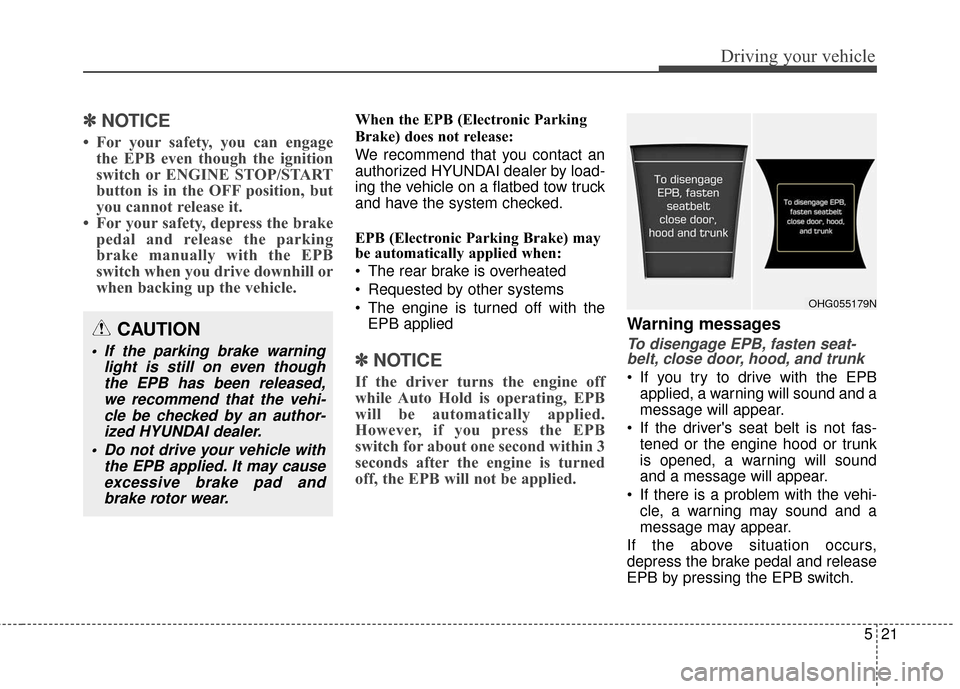
521
Driving your vehicle
✽
✽NOTICE
• For your safety, you can engage
the EPB even though the ignition
switch or ENGINE STOP/START
button is in the OFF position, but
you cannot release it.
• For your safety, depress the brake pedal and release the parking
brake manually with the EPB
switch when you drive downhill or
when backing up the vehicle.
When the EPB (Electronic Parking
Brake) does not release:
We recommend that you contact an
authorized HYUNDAI dealer by load-
ing the vehicle on a flatbed tow truck
and have the system checked.
EPB (Electronic Parking Brake) may
be automatically applied when:
The rear brake is overheated
Requested by other systems
The engine is turned off with the
EPB applied
✽ ✽ NOTICE
If the driver turns the engine off
while Auto Hold is operating, EPB
will be automatically applied.
However, if you press the EPB
switch for about one second within 3
seconds after the engine is turned
off, the EPB will not be applied.
Warning messages
To disengage EPB, fasten seat-
belt, close door, hood, and trunk
If you try to drive with the EPB
applied, a warning will sound and a
message will appear.
If the driver's seat belt is not fas- tened or the engine hood or trunk
is opened, a warning will sound
and a message will appear.
If there is a problem with the vehi- cle, a warning may sound and a
message may appear.
If the above situation occurs,
depress the brake pedal and release
EPB by pressing the EPB switch.
CAUTION
If the parking brake warning light is still on even thoughthe EPB has been released,we recommend that the vehi-cle be checked by an author-ized HYUNDAI dealer.
Do not drive your vehicle with the EPB applied. It may causeexcessive brake pad andbrake rotor wear.
OHG055179N
Page 368 of 521
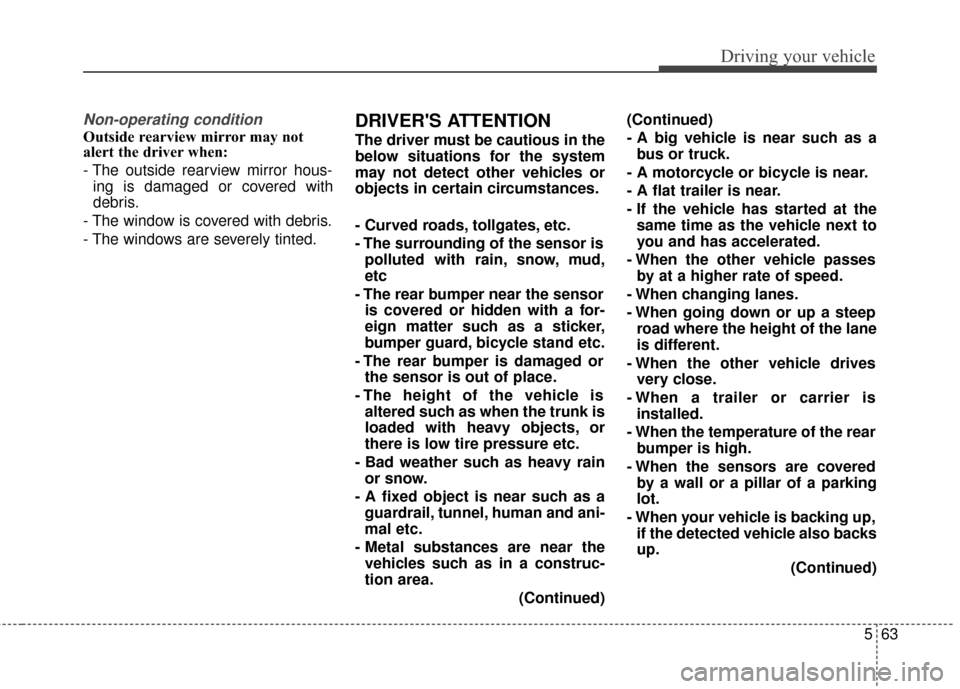
563
Driving your vehicle
Non-operating condition
Outside rearview mirror may not
alert the driver when:
- The outside rearview mirror hous-ing is damaged or covered with
debris.
- The window is covered with debris.
- The windows are severely tinted.DRIVER'S ATTENTION
The driver must be cautious in the
below situations for the system
may not detect other vehicles or
objects in certain circumstances.
- Curved roads, tollgates, etc.
- The surrounding of the sensor is polluted with rain, snow, mud,
etc
- The rear bumper near the sensor is covered or hidden with a for-
eign matter such as a sticker,
bumper guard, bicycle stand etc.
- The rear bumper is damaged or the sensor is out of place.
- The height of the vehicle is altered such as when the trunk is
loaded with heavy objects, or
there is low tire pressure etc.
- Bad weather such as heavy rain or snow.
- A fixed object is near such as a guardrail, tunnel, human and ani-
mal etc.
- Metal substances are near the vehicles such as in a construc-
tion area.
(Continued)(Continued)
- A big vehicle is near such as a
bus or truck.
- A motorcycle or bicycle is near.
- A flat trailer is near.
- If the vehicle has started at the same time as the vehicle next to
you and has accelerated.
- When the other vehicle passes by at a higher rate of speed.
- When changing lanes.
- When going down or up a steep road where the height of the lane
is different.
- When the other vehicle drives very close.
- When a trailer or carrier is installed.
- When the temperature of the rear bumper is high.
- When the sensors are covered by a wall or a pillar of a parking
lot.
- When your vehicle is backing up, if the detected vehicle also backs
up.
(Continued)
Page 402 of 521

69
What to do in an emergency
TPMS malfunctions may occur for a
variety of reasons, including the
installation of replacement or alter-
nate tires or wheels on the vehicle
that prevent the TPMS from function-
ing properly. Always check the TPMS
malfunction telltale after replacing
one or more tires or wheels on your
vehicle to ensure that the replace-
ment or alternate tires and wheels
allow the TPMS to continue to func-
tion properly.
✽ ✽NOTICE
Take your vehicle to the nearest
authorized HYUNDAI dealer and
have the system checked if any of
the below happens:
1.The low tire pressure telltale/
TPMS malfunction indicator do
not illuminate for 3 seconds when
the ignition switch is turned to the
ON position or engine is running.
2. The TPMS malfunction indicator remains illuminated after blinking
for approximately 1 minute.
3. The Low tire pressure position telltale remains illuminated.
Low tire pressure
telltale
Low tire pressure
position telltale
When the tire pressure monitoring
system warning indicators are illumi-
nated, one or more of your tires is
significantly under-inflated. The low
tire pressure position telltale light will
indicate which tire is significantly
under-inflated by illuminating the cor-
responding position light.
If either telltale illuminates, immedi-
ately reduce your speed, avoid hard
cornering and anticipate increased
stopping distances. You should stop
and check your tires as soon as pos-
sible. Inflate the tires to the proper
pressure as indicated on the vehicle’s
placard or tire inflation pressure label
located on the driver’s side center pil-
lar outer panel. If you cannot reach a
service station or if the tire cannot
hold the newly added air, replace the
low pressure tire with a spare tire. After restarting with the spare tire, the
TPMS malfunction indicator and low
tire pressure position telltale light will
remain on about 20 minutes of con-
tinuous driving, then the TPMS mal-
function indicator will blink for approx-
imately 1 minute but the low tire pres-
sure position telltale light will turn off.
✽ ✽
NOTICE
The compact spare tire is not
equipped with a tire pressure sensor.
Page 499 of 521
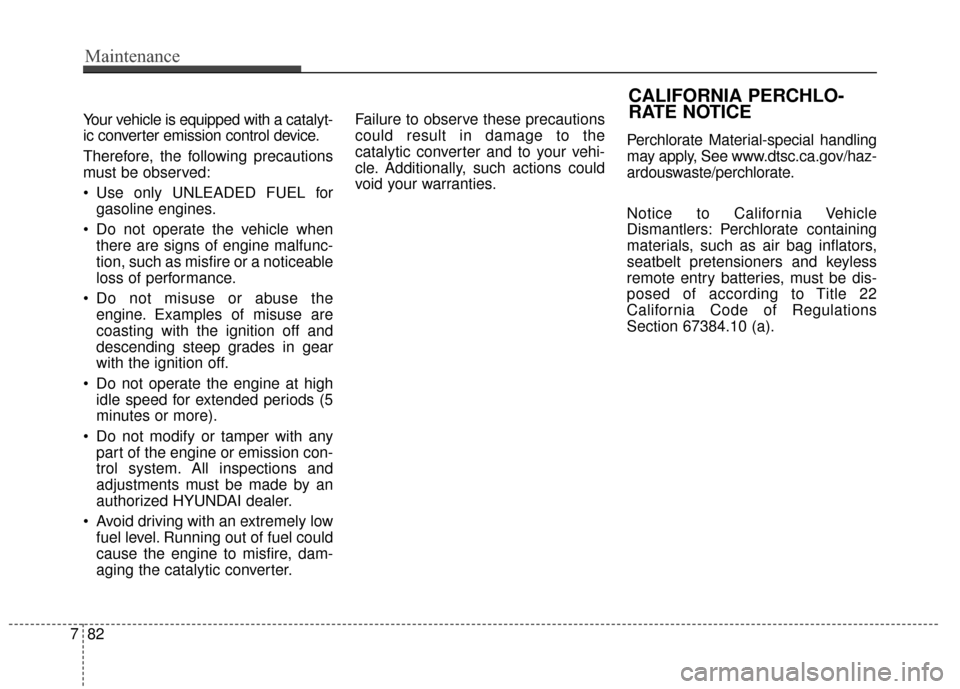
CALIFORNIA PERCHLO-
RATE NOTICE
782
Maintenance
Your vehicle is equipped with a catalyt-
ic converter emission control device.
Therefore, the following precautions
must be observed:
Use only UNLEADED FUEL forgasoline engines.
Do not operate the vehicle when there are signs of engine malfunc-
tion, such as misfire or a noticeable
loss of performance.
Do not misuse or abuse the engine. Examples of misuse are
coasting with the ignition off and
descending steep grades in gear
with the ignition off.
Do not operate the engine at high idle speed for extended periods (5
minutes or more).
Do not modify or tamper with any part of the engine or emission con-
trol system. All inspections and
adjustments must be made by an
authorized HYUNDAI dealer.
Avoid driving with an extremely low fuel level. Running out of fuel could
cause the engine to misfire, dam-
aging the catalytic converter. Failure to observe these precautions
could result in damage to the
catalytic converter and to your vehi-
cle. Additionally, such actions could
void your warranties.
Perchlorate Material-special handling
may apply, See www.dtsc.ca.gov/haz-
ardouswaste/perchlorate.
Notice to California Vehicle
Dismantlers: Perchlorate containing
materials, such as air bag inflators,
seatbelt pretensioners and keyless
remote entry batteries, must be dis-
posed of according to Title 22
California Code of Regulations
Section 67384.10 (a).
Page 512 of 521
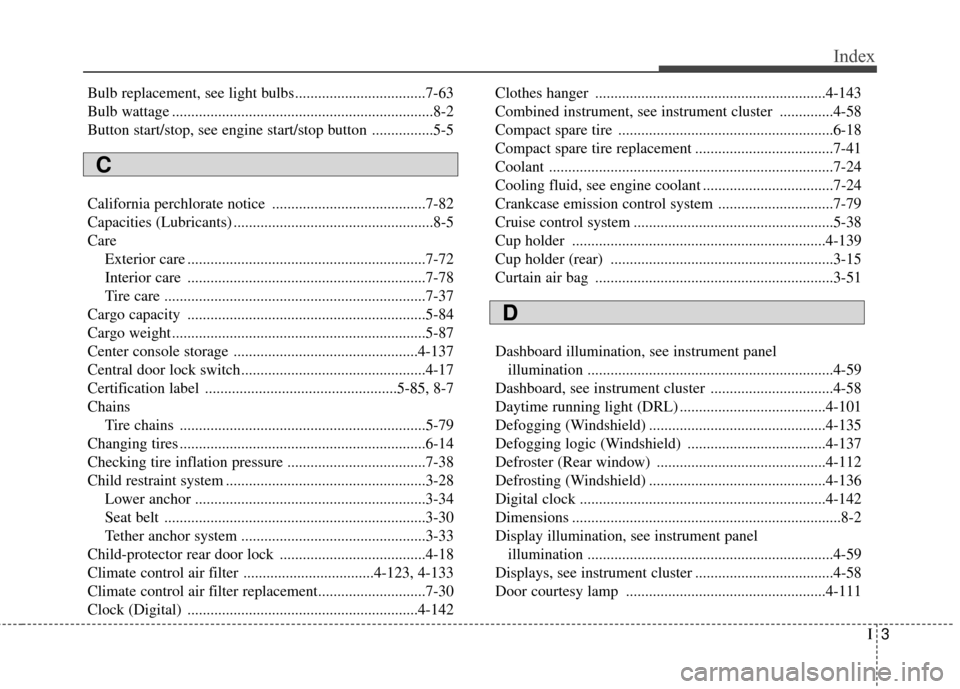
I3
Index
Bulb replacement, see light bulbs..................................7-63
Bulb wattage ....................................................................8-2
Button start/stop, see engine start/stop button ................5-5
California perchlorate notice ........................................7-82
Capacities (Lubricants) ....................................................8-5
CareExterior care ..............................................................7-72
Interior care ..............................................................7-78
Tire care ....................................................................7-37\
Cargo capacity ..............................................................5-84
Cargo weight ..................................................................5-87
Center console storage ................................................4-137
Central door lock switch................................................4-17
Certification label ..................................................5-85, 8-7
Chains Tire chains ................................................................5-79
Changing tires ................................................................6-14
Checking tire inflation pressure ....................................7-38
Child restraint system ....................................................3-28 Lower anchor ............................................................3-34
Seat belt ....................................................................3-30\
Tether anchor system ................................................3-33
Child-protector rear door lock ......................................4-18
Climate control air filter ..................................4-123, 4-133
Climate control air filter replacement............................7-30
Clock (Digital) ............................................................4-142 Clothes hanger ............................................................4-143
Combined instrument, see instrument cluster ..............4-58
Compact spare tire ........................................................6-18
Compact spare tire replacement ....................................7-41
Coolant ........................................................................\
..7-24
Cooling fluid, see engine coolant ..................................7-24
Crankcase emission control system ..............................7-79
Cruise control system ....................................................5-38
Cup holder ..................................................................4-139
Cup holder (rear) ..........................................................3-15
Curtain air bag ..............................................................3-51
Dashboard illumination, see instrument panel
illumination ................................................................4-59
Dashboard, see instrument cluster ................................4-58
Daytime running light (DRL) ......................................4-101
Defogging (Windshield) ..............................................4-135
Defogging logic (Windshield) ....................................4-137
Defroster (Rear window) ............................................4-112
Defrosting (Windshield) ..............................................4-136
Digital clock ................................................................4-142
Dimensions ......................................................................8-\
2
Display illumination, see instrument panel illumination ................................................................4-59
Displays, see instrument cluster ....................................4-58
Door courtesy lamp ....................................................4-111
C
D
Page 513 of 521
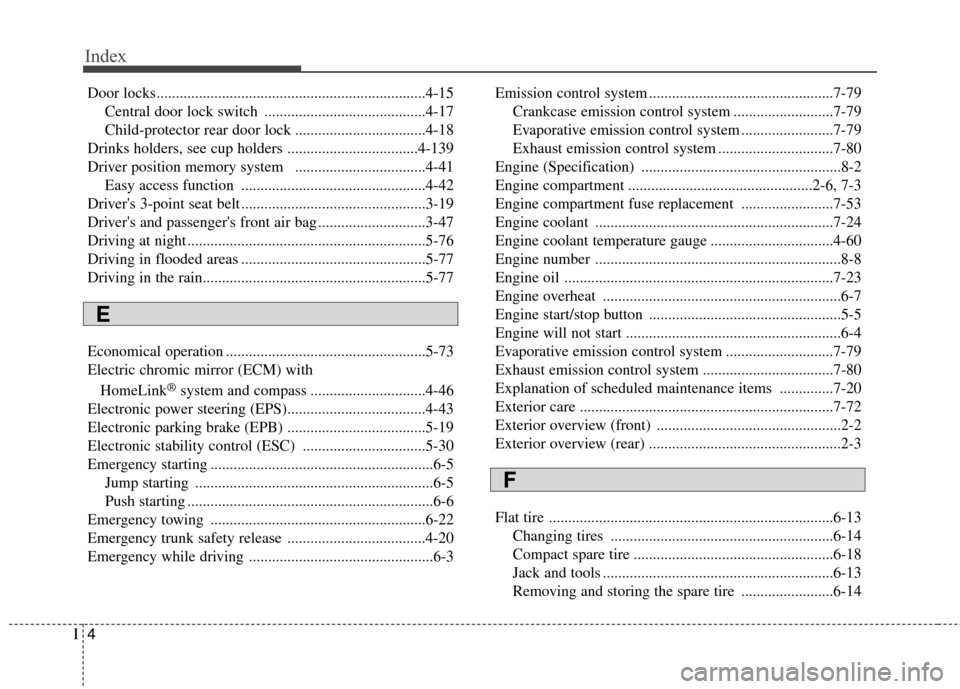
Index
4I
Door locks......................................................................4-\
15Central door lock switch ..........................................4-17
Child-protector rear door lock ..................................4-18
Drinks holders, see cup holders ..................................4-139
Driver position memory system ..................................4-41 Easy access function ................................................4-42
Driver's 3-point seat belt ................................................3-19
Driver's and passenger's front air bag ............................3-47
Driving at night ..............................................................5-76
Driving in flooded areas ................................................5-77
Driving in the rain..........................................................5-77
Economical operation ....................................................5-73
Electric chromic mirror (ECM) with
HomeLink
®system and compass ..............................4-46
Electronic power steering (EPS)....................................4-43
Electronic parking brake (EPB) ....................................5-19
Electronic stability control (ESC) ................................5-30
Emergency starting ..........................................................6-5 Jump starting ..............................................................6-5
Push starting ................................................................6-6
Emergency towing ........................................................6-22
Emergency trunk safety release ....................................4-20
Emergency while driving ................................................6-3 Emission control system ................................................7-79
Crankcase emission control system ..........................7-79
Evaporative emission control system ........................7-79
Exhaust emission control system ..............................7-80
Engine (Specification) ....................................................8-2
Engine compartment ................................................2-6, 7-3
Engine compartment fuse replacement ........................7-53
Engine coolant ..............................................................7-24
Engine coolant temperature gauge ................................4-60
Engine number ................................................................8-8
Engine oil ......................................................................7-\
23
Engine overheat ..............................................................6-7
Engine start/stop button ..................................................5-5
Engine will not start ........................................................6-4
Evaporative emission control system ............................7-79
Exhaust emission control system ..................................7-80
Explanation of scheduled maintenance items ..............7-20
Exterior care ..................................................................7-72
Exterior overview (front) ................................................2-2
Exterior overview (rear) ..................................................2-3
Flat tire ........................................................................\
..6-13 Changing tires ..........................................................6-14
Compact spare tire ....................................................6-18
Jack and tools ............................................................6-13
Removing and storing the spare tire ........................6-14
F
E